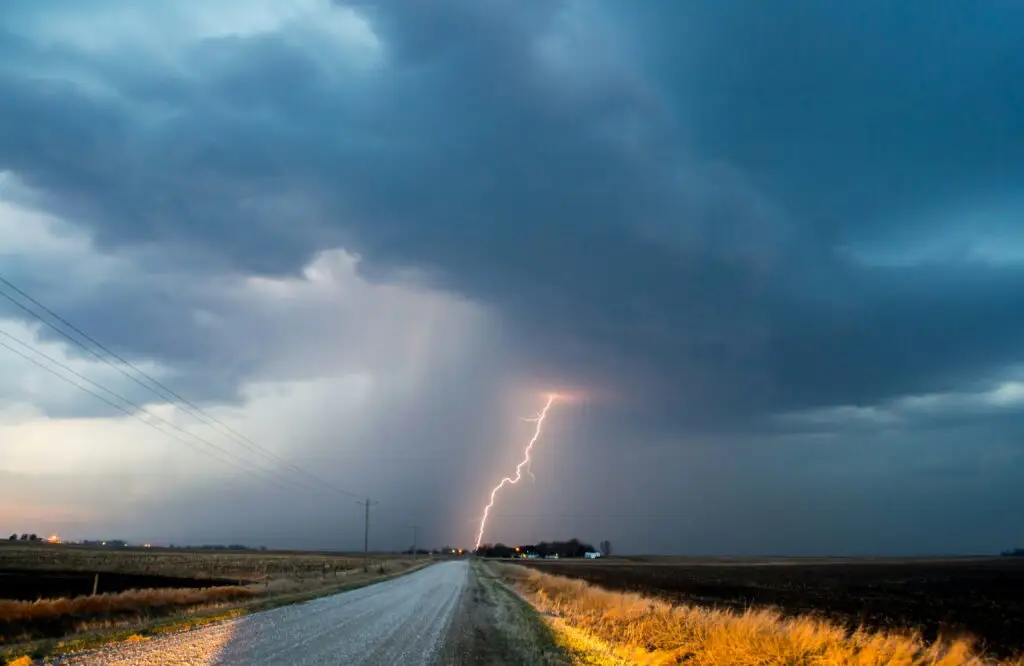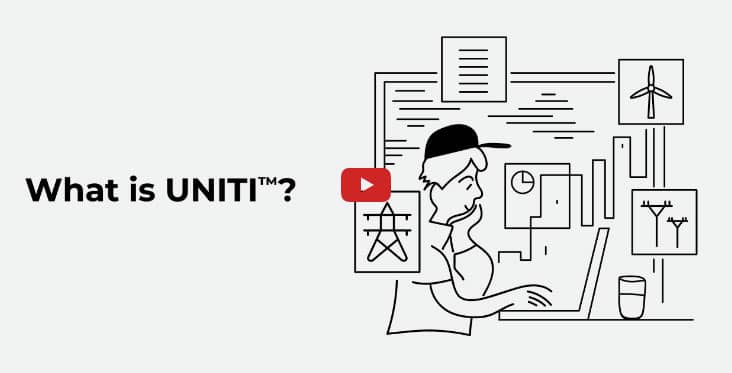The dual threat of climate change and cyberattacks pose an existential challenge for utility providers and their dated infrastructure. The US alone has 500,000 miles of high-voltage transmission lines, and around 83% of major power outages are caused by weather-related events. As these events increase in frequency, resilience is no longer an aspirational goal but a critical necessity.
The good news is that there is a solution. From predictive analytics to end-to-end encryption, the latest technologies are helping utilities safeguard their infrastructure for the long-term.
Here, we closely examine the issues and the technology. We outline a few strategies that should help to fortify grids—while ensuring operational continuity.
Contact Us
To learn more about how Thread’s UNITI Workspace can save your organization time and money, please submit the form below.
Climate Challenges to Transmission Systems
In 2023, the US recorded 28 separate weather and climate disasters, bringing around $92 billion in damage. Extreme weather events are placing unprecedented stress on transmission networks. Hurricanes in the southeastern United States, wildfires in California, and flooding in the Midwest have all disrupted critical transmission corridors in recent years.
Hurricane Helene caused nearly 4.7 million customers to lose power across the Southeastern US, and hundreds of substations malfunctioned after the storm. 4,500 transformers were damaged or destroyed, and entire sections of the power grid had to be rebuilt. Transmission towers designed decades ago are often unable to withstand the wind speeds and storm surges seen today.
Meanwhile, Florida Power & Light officials from central Florida cities like Winter Park sang the praises of undergrounding power infrastructure after their buried lines suffered less damage than traditional overhead lines, helping to minimize outages during October’s Hurricane Milton.
Undergrounding is not a cure-all, however, as buried lines can still be damaged in floods and swept away in hurricane storm surges. Instead, emerging technologies are helping to address the main vulnerabilities. For example, IoT sensors installed on transmission lines can measure environmental stressors such as temperature, wind speed, and structural strain in real-time.
For example, Florida Power & Light (FPL) employs drones to conduct inspections of transmission lines and substations. These drones use thermal and infrared sensors to detect equipment overheating or damaged components. By proactively addressing these issues, FPL prevents outages and improves grid reliability.
These tools are also helping to reduce the time required for post-event recovery.
Cybersecurity Risks and Strategies
While climate events are a visible threat, cyberattacks represent an equally dangerous but less tangible risk. Transmission networks are increasingly digitized, relying on interconnected control systems that manage load flows, substations, and switching operations.
These systems are prime targets for cyberattacks. In 2023, two-thirds of critical infrastructure operators (67%) in the oil, energy, and utility sectors suffered a ransomware attack, and we know at least 20 cyberattacks on European energy utilities the previous year were successful.
Utilities are addressing these risks by adopting layered cybersecurity strategies. End-to-end encryption and real-time intrusion detection systems are now being integrated into Supervisory Control and Data Acquisition (SCADA) networks. For example, National Grid in the UK has deployed anomaly detection algorithms powered by machine learning.
The new system helps to identify unusual patterns in data traffic that may signal a cyber breach. Multi-factor authentication and secure API connections are also becoming standard practice, ensuring that only authorized personnel can access critical systems.
For now, compliance with standards like the North American Electric Reliability Corporation’s Critical Infrastructure Protection (NERC CIP) guidelines is helping to drive improvements across the energy sector. These guidelines mandate regular cybersecurity audits and the implementation of defense-in-depth measures to protect operational technology.
For utilities managing thousands of transmission assets, ensuring cybersecurity requires not only robust systems but also ongoing training for personnel to respond effectively to new threats.
Technological Solutions For Resilience
Resilience in the face of these challenges relies heavily on advanced technologies that integrate real-time data with automated responses. AI-powered platforms are at the forefront, offering utilities the ability to predict equipment failures, optimize load balancing, and dynamically adjust network configurations.
Drones equipped with LiDAR and multispectral sensors are revolutionizing the way utilities monitor transmission infrastructure. By capturing high-resolution data, these drones provide detailed assessments of tower stability, conductor sag, and vegetation encroachment. During Hurricane Ian, automated analysis of drone footage expedited repairs by identifying priority areas for restoration.
Furthermore, composable platforms like UNITI Workspace enable utilities to centralize data from IoT devices, drone imagery, and historical data into a single interface. This approach not only improves operational visibility but also supports event-based actions, such as triggering maintenance alerts.
Integrated Approaches to Asset Management
One of the most significant advancements in grid resilience is the integration of asset management systems with predictive and real-time monitoring technologies. This approach moves utilities away from reactive maintenance, where issues are addressed after they cause outages, to condition-based strategies that anticipate and mitigate problems before they escalate.
By using integrated systems, utilities can coordinate data from diverse sources, such as IoT sensors, drones, SCADA systems, and GIS platforms, into a unified framework that supports comprehensive decision-making.
A compelling example is the use of composable architectures in transmission line management. Unlike traditional systems that operate in isolation, composable architectures allow utilities to layer new technologies onto existing infrastructures without extensive system overhauls. In Texas, one transmission operator employed such an approach during the 2023 winter storms.
This system was used to dynamically adjust load flows based on real-time data. By integrating predictive analytics with weather forecasts and line performance metrics, the operator prevented cascading failures and avoided widespread outages. This ability to adapt infrastructure management dynamically is becoming a cornerstone of grid resilience.
Beyond technical integration, composable platforms such as UNITI Workspace emphasize collaboration by providing centralized dashboards accessible to all stakeholders, from field technicians to network engineers. This eliminates communication delays, ensuring that data from inspections or repairs is immediately actionable.
For instance, when high winds in 2023 threatened transmission corridors in the Midwest, integrated platforms enabled teams to deploy crews in advance, targeting the most at-risk sections of the grid. These preemptive measures reduced downtime by over 40%, showcasing the efficiency of unified data environments.
Reducing Downtime Through Automation
Automation has proven critical in minimizing downtime and enhancing the speed of recovery after events. It enables rapid data processing, ensuring that high volumes of information collected during inspections are used effectively. This is especially relevant during emergencies, when the ability to process thousands of images, sensor readings, and operational metrics quickly can mean the difference between localized damage and widespread outages.
Drones are playing a large part in this transformation. Equipped with LiDAR and thermal imaging, they can perform inspections of transmission lines over hundreds of miles in a single flight. Unlike traditional inspections, which may take days or weeks, drone-assisted surveys can be completed in hours, with data automatically uploaded to platforms like UNITI Workspace for analysis.
For example, during California’s 2023 wildfire season, automated image classification software processed drone footage to identify compromised transmission towers within minutes, enabling targeted repairs that significantly reduced restoration times.
Substations also need an intelligent solution, particularly against a background of decentralized renewable energy, the alternating direction of power flow, and load fluctuations. That’s why Siemens has unveiled its Future Distribution Substation. It is equipped with IoT-enabled transformers and breakers, which can self-monitor their condition and trigger alerts when anomalies are detected.
With this Siemens solution, utilities benefit from cloud-based analysis of power quality problems, grid anomalies, and outages. They can easily check oil level, oil or winding temperature, low-voltage winding current, and GPS location with just a few clicks. Downtimes can be reduced from hours to several minutes thanks to the possibility of remote control.
Keeping the Power On
It’s important not to underestimate the poor performance of modern utility providers in accurately predicting outages, as well as load and energy demand (due to a lack of weather forecast parameters), inconsistent data and outdated technology. Remarkably, in the runup to Winter Storm Elliott in December 2022, the total load forecast was underestimated by 23,047 MW.
While natural disasters, cyberattacks and other threats are inevitable, the power of data, AI, intelligent weather insights, IoT, geospatial technology and advanced asset management technologies can drastically enhance disaster management, protect the grid, and help utility providers achieve impressive cost saving efficiencies.



